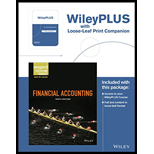
Concept explainers
Balance Sheet:
Balance sheet shows the available assets (owner’s equity and outsider’s equity) and owed liabilities from investing and financial activities of a company. This statement reveals the financial health of company. Therefore, this statement is also called as the
Cash:
Cash represents legal tender or coins used to exchange goods or services and debt. Cash also includes the value of assets, which can be further converted into cash, as recorded by a business entity. It is also called money, in its physical form.
Accounts receivable:
The amount owed by customers to a business is called account receivable. It can be converted into cash on a future date, as the business has provided its service or product but has not received payment yet.
Accounts payable:
The amount owed by a business is called accounts payable. It results in the loss of cash, as it is to be used in the future for making payments to debtors. This happens when the business has not provided its service or product but has received payment.
Common stock:
It is the share of ownership offered to stockholders in lieu of their money invested in the business. The shareholders are paid by a business from the profit earned in the form of dividend. As it is paid from the profit to the shareholders, it automatically becomes a part of shareholders’ equity.
To prepare: The balance sheet of Company E as on December 31, 2019.
Want to see the full answer?
Check out a sample textbook solution
Chapter 1 Solutions
Financial Accounting, 10e WileyPLUS Registration Card + Loose-leaf Print Companion
- Please provide the answer to this general accounting question using the right approach.arrow_forwardPlease provide the accurate answer to this general accounting problem using appropriate methods.arrow_forwardI am looking for the most effective method for solving this financial accounting problem.arrow_forward

 AccountingAccountingISBN:9781337272094Author:WARREN, Carl S., Reeve, James M., Duchac, Jonathan E.Publisher:Cengage Learning,
AccountingAccountingISBN:9781337272094Author:WARREN, Carl S., Reeve, James M., Duchac, Jonathan E.Publisher:Cengage Learning, Accounting Information SystemsAccountingISBN:9781337619202Author:Hall, James A.Publisher:Cengage Learning,
Accounting Information SystemsAccountingISBN:9781337619202Author:Hall, James A.Publisher:Cengage Learning, Horngren's Cost Accounting: A Managerial Emphasis...AccountingISBN:9780134475585Author:Srikant M. Datar, Madhav V. RajanPublisher:PEARSON
Horngren's Cost Accounting: A Managerial Emphasis...AccountingISBN:9780134475585Author:Srikant M. Datar, Madhav V. RajanPublisher:PEARSON Intermediate AccountingAccountingISBN:9781259722660Author:J. David Spiceland, Mark W. Nelson, Wayne M ThomasPublisher:McGraw-Hill Education
Intermediate AccountingAccountingISBN:9781259722660Author:J. David Spiceland, Mark W. Nelson, Wayne M ThomasPublisher:McGraw-Hill Education Financial and Managerial AccountingAccountingISBN:9781259726705Author:John J Wild, Ken W. Shaw, Barbara Chiappetta Fundamental Accounting PrinciplesPublisher:McGraw-Hill Education
Financial and Managerial AccountingAccountingISBN:9781259726705Author:John J Wild, Ken W. Shaw, Barbara Chiappetta Fundamental Accounting PrinciplesPublisher:McGraw-Hill Education





